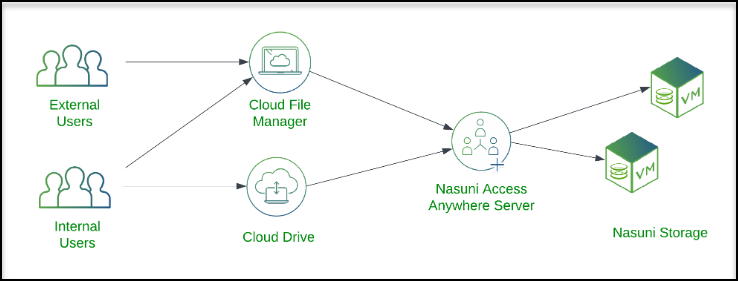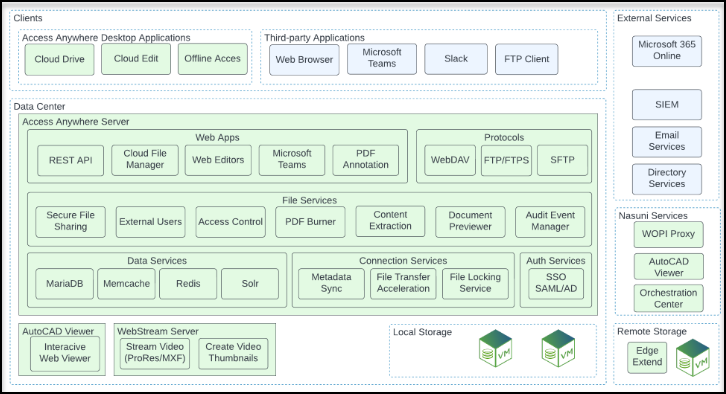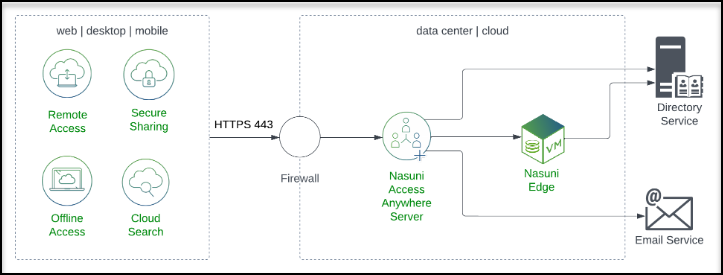Introduction
Nasuni Access Anywhere is a scale-out solution for remote file access, external file sharing/collaboration, and data governance. Access Anywhere can be deployed in several environments, both on-premises and in the cloud. This guide assists users with deploying and sizing Access Anywhere Servers.
Overview
Users access their storage primarily through the Access Anywhere Cloud Drive or any web browser through the Cloud File Manager. External users can access shared files and folders through secure links or Microsoft Teams.

Cloud Drive
The Cloud Drive provides Windows or Mac users access to their network file systems through a virtual filesystem. Users can browse and open files with their favorite desktop applications, including Microsoft Office. The drive provides high-performance access to remote files with support for global locking, caching, and offline access.
Cloud File Manager
The Cloud File Manager provides users remote access to all their file systems from any web browser. With support for search support, the ability to preview files, and collaborative web editing for office documents, users can quickly find and work with the files they need. With Cloud Edit, users can launch desktop applications for files directly from the web browser.
External users can access select files and folders through shared links. Authentication can be required, and users may be allowed to upload and edit files.
Access Anywhere Server
The Access Anywhere Server supports remote access, search, file sharing, and other services by indexing all files and folders - file names, size, timestamps, and permissions. Files remain on their respective file systems and are only streamed to (or from) the client applications only when needed. This means users and applications can continue to access file systems directly, and users can access data remotely without needing to reconcile changes.
Component Architecture
The Nasuni Access Anywhere Server is built with a service-oriented or component-based architecture. These application and data services can be co-located on a single server or virtual machine or deployed across a cluster of many servers.
The following diagram lists the primary components within the Access Anywhere Server and the external services that can also be deployed.

Single Node Deployment
A Nasuni Access Anywhere site is built using a service-oriented or component-based architecture. Application and data components are co-located on a single server or virtual machine.
The node must be connected to an LDAP or SAML service for authentication and an email service for sharing links and sending verification codes. VPN-less access is provided through desktop tools and a web application through a single public endpoint over HTTPS.

Nasuni Edge Appliances
An Access Anywhere site is deployed alongside one or more Nasuni Edge Appliances with the shares for which it provides remote access and secure sharing.
For acceptable performance Nasuni Edge Appliances should be in the same local network as Access Anywhere.
We recommend limiting the number of shares to 25-30 as each Multiuser SMB/Nasuni provider adds about 0.25 seconds to the login time.
Access Anywhere can connect to filers through the Microsoft Distributed File System (DFS).
Note: SMB Storage Locking is not supported with DFS.
Instance Backups and High Availability
With a single node, high availability can be provided by replicating the virtual machine through the hypervisor or taking daily snapshots of the virtual machine. The site can be recovered by launching the previous backup of the virtual machine.
Node Sizing
A node should be sized based on the expected user load and number of items indexed. As a starting point, we recommend the following minimum configurations. For larger numbers of users or files, use the following grid to view multi-node deployment options.
Technical Specifications | Small | Medium | Large |
Max Users | 500 | 1000 | 2000 |
Max Users with M-stream | 100 | 500 | 1500 |
Max Number of Files | 5 million | 50 million | 250 million |
DB Disk Type | SSD | SSD | SSD |
DB Disk Size (GB) | 200 | 250 | 250 |
Processor Cores (vCPUs) | 8 | 12 | 16 |
VM memory (GB) | 10 | 14 | 32 |
NAA Self-Guided User Interface Training
This documentation-style course provides an overview of the functions and uses of Nasuni Access Anywhere (NAA). Content is provided for the NAA web app as well as Cloud Drive for Windows and Mac. Searchable how-to content is presented in organized modules containing short silent videos, screenshots, and quick steps for common workflow tasks. Each module ends with a suggested hands-on learning activity designed to help users retain what they've learned and how to apply it to their daily workflows.
To learn more about the user interface, check out the NAA End User Training.
To submit feedback on the training, email Nasuni-customer-academy@nasuni.com.